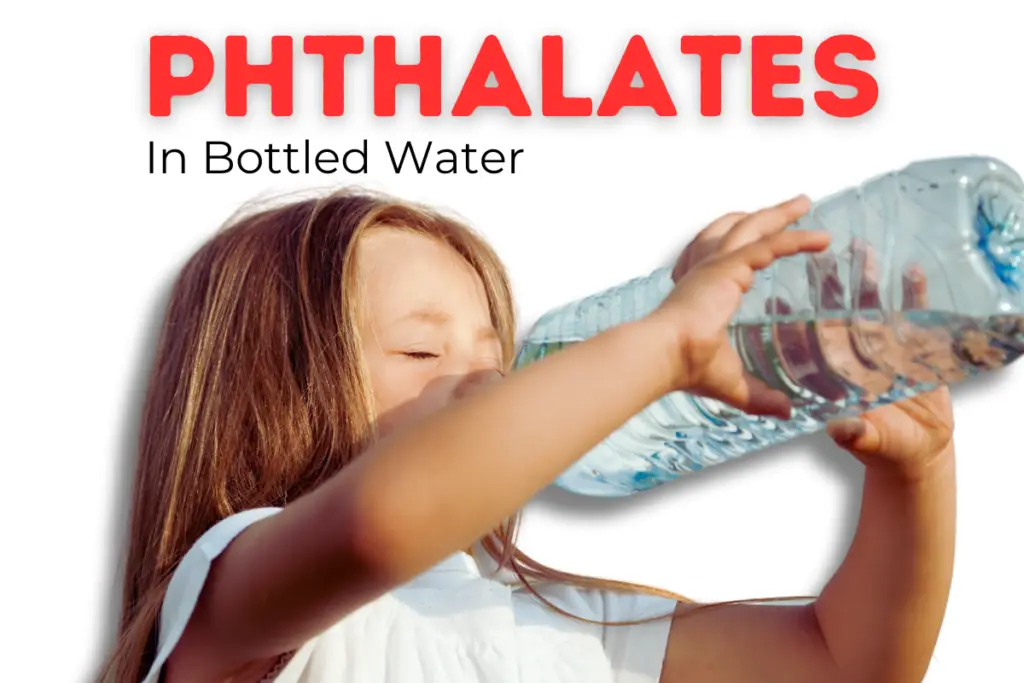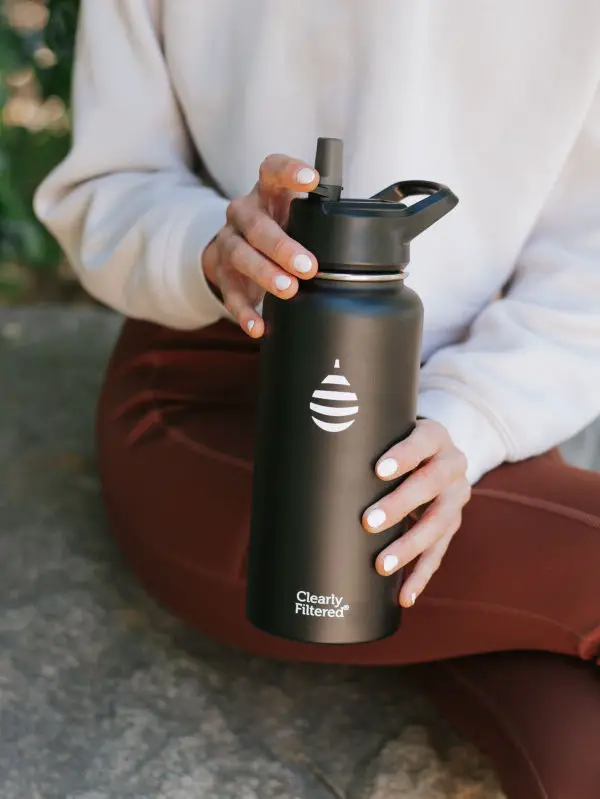Recent concerns have arisen about the presence of a group of organic compounds known as phthalates in bottled water, and their potential impact on public health.
Phthalates are found in bottled water, but are generally considered safe at low concentrations. Although, in some countries, phthalate levels exceed the U.S FDA limit of 6 μg/L, which can potentially affect hormonal balance and health. High temperatures, extended storage, sunlight exposure, and the acidity or alkalinity of water can increase phthalate leaching into bottled water.
In this article, we will explore what phthalates are, their health implications, the levels found in bottled water, and what you can do to reduce your exposure.

What Are Phthalates?
Phthalates, often referred to as plasticizers, are a group of chemical compounds used in a wide range of products, including wall coverings, toys, food packaging materials, and even blood bags. These compounds are employed to make hard polyvinyl chloride (PVC) resins more flexible and workable. While they serve a vital role in various industries, they have come under scrutiny due to their potential adverse effects on human health.
Health Concerns of Phthalates
Phthalates have come under scrutiny due to their association with several health concerns, particularly when exposure levels are high. Key issues include:
- Endocrine Disruption: Phthalates, especially types like DBP and DEHP, are known to disrupt the endocrine system, responsible for regulating hormones in our bodies. This disruption can lead to problems related to reproduction, development, and metabolism.
- Reproductive and Developmental Effects: Exposure to certain phthalates can lead to fertility problems in both men and women. These compounds can affect sperm quality, fertility, and even the development of male reproductive organs.
- Developmental Effects: Babies can be affected even before birth if their mothers are exposed to phthalates during pregnancy. Such exposure may lead to developmental problems, including altered genital development in boys or cognitive and behavioral issues.
- Respiratory Disorders: Inhaling phthalates, especially for children, can contribute to respiratory problems such as asthma and allergies.
- Allergic Reactions: Some individuals may develop allergies or skin sensitivities from personal care products containing phthalates.
It’s important to note that the impact of phthalates can vary depending on factors such as the specific type of phthalate, the level of exposure, and individual sensitivity. Not all phthalates are equally harmful, and some are considered safe in materials that come into contact with food.
Phthalate Maximum Contaminant Levels
In response to concerns about phthalates in bottled water, regulatory agencies have established maximum contaminant levels.
In the United States, the Food and Drug Administration (FDA) recommends that phthalates in bottled water should not exceed 6 micrograms per liter (ug/L).
The World Health Organization (WHO) has set a slightly higher limit at 8 ug/L.
These limits are in place to protect consumers from potential health risks associated with high phthalate exposure.
Types and Amounts of Phthalates Found in Bottled Water
Recent research has shed light on the types and quantities of phthalates detected in bottled water across the globe. Five main types of phthalates were identified in more than three hundred bottled water brands from various countries around the world, excluding the U.SA. The most common types of phthalates were:
- dibutyl phthalate (DBP) – Present in 67.6 % of tested bottles
- di-2-(ethylhexyl) phthalate (DEHP) – Present in 61.7 % of tested bottles
- diethyl phthalate (DEP) – Present in 47.1 % of tested bottles
- benzyl butyl phthalate (BBP) – Present in 36.9 % of tested bottles
- dimethyl phthalate (DMP) – Present in 30.1 % of tested bottles
The concentration of each phthalate type varied between countries, with the highest average levels recorded in Mexico, Thailand, Pakistan, Saudi Arabia, and China. Some individual bottles of water contained extremely high concentrations of phthalates, well above the FDA and WHO limits.
The highest phthalate concentration was recorded in bottled water from China at 222 μg/L; when compared to U.S. thresholds, that’s 37 times the allowable limit!
Conditions That Increase Risk of Phthalates Leaching into Bottled Water
Several factors and conditions can increase the likelihood of phthalates migrating from plastic bottles into the water they contain:
- High Temperatures: Phthalates are more likely to leach into water when bottles are exposed to heat, like being left in a hot car or stored in warm conditions. Keep your bottled water cool to reduce this risk.
- Prolonged Storage: The longer water sits in a plastic bottle, especially under less-than-ideal conditions, the greater the chance of phthalate migration. Over time, the plastic can degrade, making it easier for phthalates to seep into the water.
- Exposure to Sunshine: Direct sunlight can also increase the risk of phthalates leaching into bottled water. Solar water disinfection (SODIS) can accelerate plastic decomposition, encouraging phthalate migration. Store plastic containers, including bottled water, in a cool, dark place.
- pH of the Water: The verdict on whether pH increases phthalate migration into bottled water is still undecided. Some studies show that the more acidic (lower pH) the bottle’s contents, the higher the risk of phthalates leaching. However, the majority of research points to alkaline water (higher pH) increasing the likelihood of phthalates leaching into the water.
- Reusing Plastic Bottles: While reusing single-use PET bottles may seem eco-friendly, it can lead to plastic breakdown and increased phthalate leaching, especially if bottles are exposed to high temperatures.
- Plastic Quality: Lower-quality plastics are more vulnerable to phthalate leaching. Some phthalates are also more likely to transfer from plastic materials. The FDA has strict regulations to ensure that plastic containers, including bottled water, meet safety standards.
Why Bottled Water Contains Phthalates
The primary reason phthalates are found in bottled water is the material used for the bottles themselves. Most bottled water is packaged in PET (polyethylene terephthalate) plastic bottles. While PET is generally considered safe for single use, it may contain small amounts of phthalates if it’s made with ingredients that include these compounds.
Many PET bottles are made from recycled plastic, and if the recycled plastic contains phthalates, traces of these chemicals may remain. Variations in production methods and quality control among companies can also affect the presence of phthalates in bottled water.
Types of Phthalates
In the context of bottled water and PET bottles, the following phthalates are commonly found:
- Dibutyl Phthalate (DBP): Used as a plasticizer in PVC materials, DBP can sometimes be detected in PET plastic bottles. It’s of particular concern due to its potential to disrupt hormone function and its adverse effects on reproductive health.
- Di-2-(Ethylhexyl) Phthalate (DEHP): Another prevalent phthalate found in plastic materials, including PET bottles, DEHP has been associated with endocrine disruption, reproductive issues, and adverse health effects.
While DBP and DEHP are the most widely studied, there are several other phthalates that may also be present in plastic materials. Some of these include:
- DEP (diethyl phthalate),
- BBP (benzyl butyl phthalate),
- DMP (dimethyl phthalate),
- DiDP (diisodecyl phthalate),
- DiNP (diisononyl phthalate),
- DnOP (di-n-octyl phthalate).
What You Can Do About Phthalates
Reducing your exposure to phthalates is possible with a few simple steps:
- Alternative Materials: Consider using alternative water container materials such as glass or stainless steel bottles. These materials do not contain phthalates and are considered safe for drinking water.
- Water Filter Bottles: Look for water filter bottles that indicate their ability to remove phthalates. Some brands such as Clearly Filtered and Epic Water indicate that their filter bottles remove different types of phthalates.
- Proper Storage: Regardless of the container, store bottled water in a cool, dark place, away from direct sunlight and high temperatures. This reduces the risk of phthalates leaching into the water.
While phthalates in bottled water are unlikely to pose a significant concern at low concentrations, it’s essential to remain informed about potential health risks. High levels of phthalates in bottled water, as seen in some countries, can have implications for hormonal balance and health. By understanding the factors that increase phthalate leaching and taking steps to reduce exposure, consumers can make informed choices about their drinking water sources.
Whether you choose to continue using PET bottles or opt for alternative materials, staying informed and vigilant about the quality of bottled water is crucial for your well-being.
The Best Water Filter Bottle We’ve Ever Used
Clearly Filtered | Stainless Steel Filter Bottles
We really love these filter bottles for keeping your drinks cool and contaminant free! They remove 99.9% of over 220 contaminants and use BPA-free plastics and double-walled stainless steel to produce some awesome looking designs with numerous bottle sizes for every situation. You can find them here at Clearlyfiltered.com

